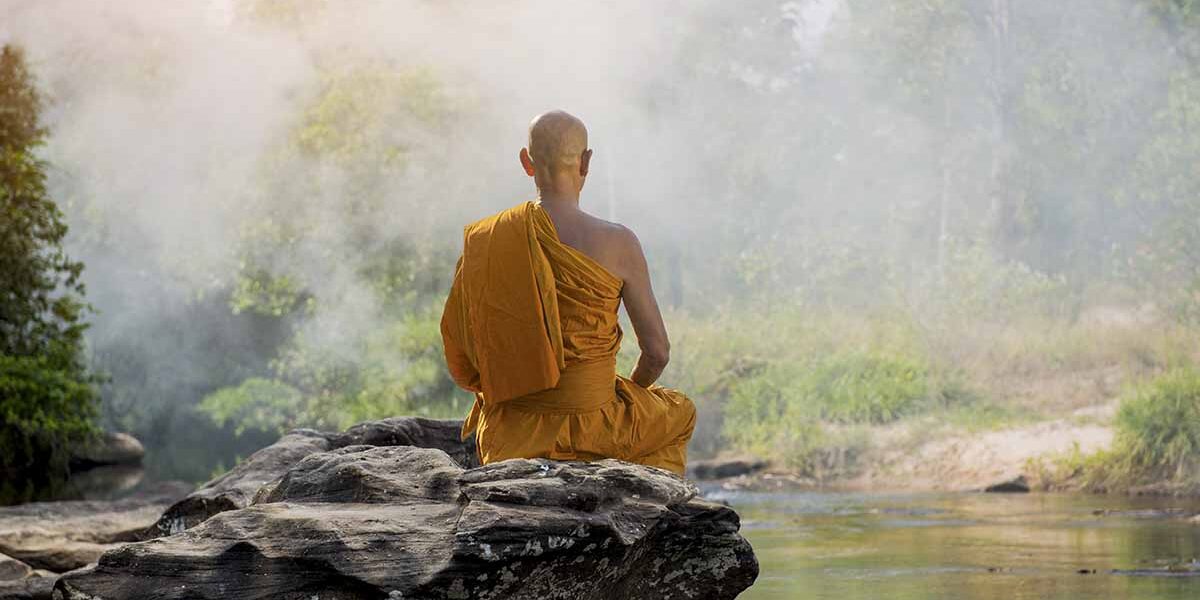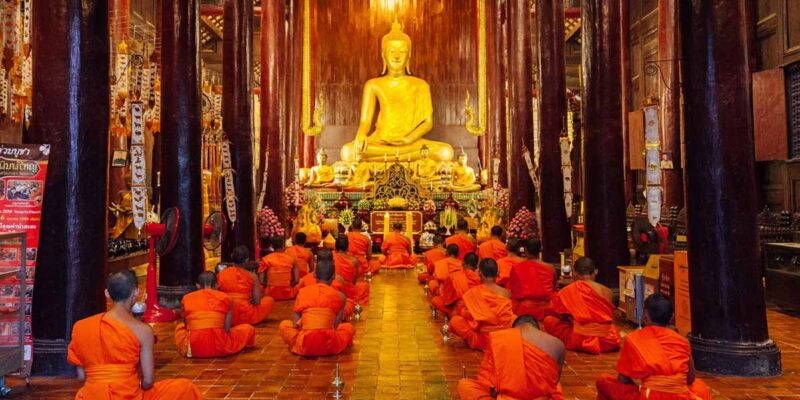Neuro and Psycho pathological complications are now receiving exceptional attention in scientific trainings, exactly what the Buddha taught 26 centuries ago. Modern medicine confesses that there is an ultimate interdependence of mind and body at all phases of physical ailments. Buddhist teachings however, go a step further, it adds more importance to mental faculties, it says mind is the fore-runner of all sensations and occurrences.
Buddha left Rajagahanuwara and travelled by foot, instead of using psychic powers in a two month voyage delivering Dhamma to inhabitants on the way, before reaching Kapilawastupura on the Medin Full Moon Day.
To neutralize the pride of his relatives in this instance Buddha had to exhibit delusionary effects with his psychic powers, Yamamaha. The following mornings the entourage was on alms rounds led by the blessed one, where he had to explain his ancestry to a shocked father who objected to the practice. However, the Buddha visited the castle for noon alms. The king and other seniors in the kingdom received the Buddha with great reverence, except Yasodharavo, Bimbadevi, the mother of Rahula and former wife. She chose to remain inside her chambers.
The most ardently focused event, the emotional meeting between the Buddha and Bimbadevi took pace on Medin Full Moon Day at the King Suddhodhana’s palace in Kimbulwatpura 26 centuries ago. The King sent a message to her, but Yasodhara Bimbavo replied in the negative. Instead, she expected the Buddha to visit her chamber.
The Buddha, having learnt that she had declined to appear, straight away strolled to her compartments, demonstrating his unassertive qualities and well-mannered regard for his earlier partner in samsara. “Bimbadevi not having seen me for a long time, she is extremely distressed, unless you allow its natural course, her heart will slash. In the event she touches the Thathagatha (Buddha), let’s not prevent her”. She was relaxing in her room clad in uncaring fabrics, and her hair cut. As the Buddha cross the threshold, from the wealth of her warmth, like a brimming bowl she was incapable to hold her admiration. For a moment she failed to recall that the man whom she treasured most was now the noblest of the world. She seized his feet and sobbed frantically. However, comprehending that the king was present, she rose from there and took a seat at a little distance. By allowing Bimbavo to spend-off her grievance in that harmless manner – didn’t he teach the world a lesson in Psychotherapy?
Saga of celestial nymphs, Janapadakalyani and the charred monkey
“On departing from home, sir, a Sakyan girl, the loveliest in the land looked up at me and said, ‘may you return soon master.’ These warm and affectionate words and her beloved’s tears stirred me deeply and remain to do so – Recollecting that, Oh Lord! I am unable to continue the holy life…”
“… Cheer up Nanda. I promise that you will join the company of those gorgeous celestial nymphs if you persist as I offer you and take preference in living the Holy Life” – Buddha.
Buddha visited his step brother Prince Nanda the following day at his palace who was planning to get married to the most gracious woman at the time, Janapadakalyani, the loveliest damsel of the kingdom the next day. Kalyani was highly excited with the prospect of her marriage. Prince Nanda expected the Buddha to take back the bowl near the entrance to the monastery, which he did not do. So, Nanda left the palace and kept his prospective bride waiting. Buddha had taken him to the monastery to give up house-hold life.
“I am discontented with leading the holy life. Friends, I am unable to endure the holy life” which was conveyed to the Buddha, Nanda Thera admitted the fact, saying, “The warm and affectionate words and her beloved’s tears stirred me deeply and continuous to do so.” The Buddha, who with his heavenly eye saw Nanda, with a little determination, could swab the Dhamma and supreme contentment of insight. He thought of a little psycho analytic and therapy to retain him in the holy life without disturbing his present frame of mind – comparison of Celestial Nymphs, and Janapadakalyani and the charred monks.
“What do you think Nanda? Who is more beautiful, fairer to look at, and more appealing, Kalyani or the gorgeous celestial numphs? Earlier, on the way the Buddha made Nanda witness a scene of a charred body of a female monkey in a Chena. Replying Nanda said, compared to these nymphs, that girl is like the charred body of the female monkey. The Buddha practicing a bit of psychology and psycho analaysis of his immature mind assured him to get him any of those nymphs as his bride to be, on condition that he will not leave the monastery. “Revered Sir, if you guarantee, I shall be content with monastic life” he promptly replied.
Buddha was the physician and the surgeon of the psyche. He believed treating the cause, not the symptom (Nidhana) as practiced in modern psychotherapy. According to Dhamma, all human disorders are basically mind related and stem from three unhealthy motivating factors, namely, attraction (Lobha), repulsion (Dhosa) and delusion (Moha). Realizing the unwholesomeness of all compounded things and endeavored for achievement, Nanda became an Arhant. Thus Buddha used his skills in psycho-therapy during his Kapilavastu mission. “Sabbe Satta Ummattaka” Buddha said it is difficult to find a being in perfect bodily health. But indeed far more challenging to find a completely mentally well person” – Roga Sutta (Annguttara Nikaya)
Leading men in the field like Sigmund Freud and his associates, Cari Jung, Otto Rank and Adler used hypnosis as the basis for analyzing the cause, but gave up developing the concept of “Free Association”, another skill that the Buddha applied as well. Buddha attached lot of importance to the development of co-operation and attachment between the therapist and the patient quite a few modern psychologists have professed this line of treatment. The two-way or dialogue from preaching used by the Buddha has a close parallel to what today’s psychiatric approach to mental patients. Buddhist psychotherapy cures mental illnesses, enables understanding of the working of their conscious and unconscious minds. One can use it to develop his own mental health in today’s stressful society. The aspects that cause mental illnesses are recognized as Kleshes or mental destructions. The basic vision behind this method is found in Satipattana Sutta, Sabbasava Sutta, and Vathupama Sutta (Majjima Nikhaya) Martin Wickramainghe, our legendary writer, author and intellectual once said, “Psycho-analysis was not initiated by Sigmund Freud, but by Jataka story teller.”
By K.K.S Perera




